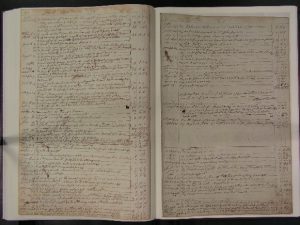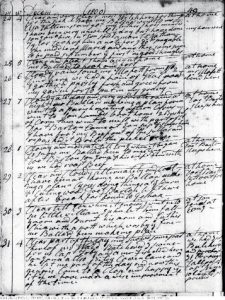 S. & W. Howard account book 3, showing the Asa Williams account. Courtesy of Linda Novak, Director/Curator, Old Fort Western
S. & W. Howard account book 3, showing the Asa Williams account. Courtesy of Linda Novak, Director/Curator, Old Fort Western
There are those theorists who say that time is a river with many bends, and that if we could look back around one of those bends, we’d see the past. I think of that whenever I cross the Kennebec River here in Augusta on my way to Old Fort Western. If I could see around the river’s bend, would I see my ancestor, the Pilgrim John Howland, arriving to establish the Cushnoc Trading Post for the Plymouth Colony in 1628? I might find my house-builder cousin, Asa Williams, on his way to the Fort in 1777, or his brother Seth trading at the S. & W. Howard store in 1790. Maybe my great-great-great-great-grandfather George Read would be galloping by to call the midwife Martha Ballard to help deliver his first child,[1] or perhaps I’d see that same midwife on her way to view an autopsy in Eunice (Fisher) Williams’s kitchen.[2] No matter where I go in this area, history is ever present, almost tangible, and beckons to everyone to listen, investigate, and absorb its lessons.
I wanted to know how my late-eighteenth- and early-nineteenth-century ancestors interacted with the people of the Fort Western Settlement every day, what they traded or bought from the Howard store, and why. I have no primary source material from those Fisher, Williams, or Read families, and only a few pieces from my side of the Coney family. Fortunately, other residents weren’t as reticent as my family (or as inclined to paste newspaper clippings over old account book pages!).
I started by reading through the four Howard store account books. Fort Western was established as a military supply depot in 1754 with a small garrison but was decommissioned and sold to its captain, a Scots-Irishman named James Howard, in 1767. James established his trading post with sons Samuel and William (the S. & W. Howard store) even before my ancestors arrived in 1777. The account books stored by Old Fort Western show few entries under Asa Williams’s name, one of which simply listed “for debt.” Further investigation at the Registry of Deeds showed James Howard granting Asa a mortgage for the purchase of land from Daniel Bolton (who later married Asa’s daughter-in-law’s grandmother, Reliance Pratt Hovey). That mortgage was, I believe, the entry “for debt” listed in the Howard account book. It’s also another piece of evidence that the Fort Western settlement residents all knew each other, and many times were related to each other. Many of them came to Maine together from the same areas in Massachusetts. Such are the roots of my family, a twisted knot of tethers!
The account books stored by Old Fort Western show few entries under Asa Williams’s name, one of which simply listed “for debt.”
The local economy in the last part of the eighteenth century was based on barter and trade; payment in cash (silver) was occasional. Brother Seth Williams frequently traded at the Howard store offering his goods (leather, shoes, etc.) for what he needed or as payment to or for someone else. But why was Asa listed so few times in all those account books, which record decades of commerce? One account book shows Asa’s trades on the left page and “contra” or his “credit” on the opposite page. He could designate his payment or profit to or for another resident who had traded with him. In other words, the Howard store, and James Howard in particular, operated as the local bank.
Both Asa and Seth prospered as blacksmiths, farmers, and cordwainers, made shoes for both man and beast in the settlement, and apparently kept most of their reciprocal trades to themselves (thus avoiding account entries and paying taxes at the store!). Midwife Martha Ballard sometimes accepted cheese in payment for her services. She came to Asa Williams to have her shoes repaired as well.[3] It’s fascinating to learn through these accounts how different products moved into and around the Fort Western Settlement. Rum, molasses, corn, leather, chocolate, sugar, flour, salt, wood and boards, lampblack, cotton wool, silk, sherry, and the (very) occasional supply of cognac brandy were some of the popular trades. A portion of what they produced for their own use was bartered or traded for those items that they couldn’t make themselves, like chocolate. The result was cooperation, codependency, and reliance on each other, knitting the few people in the settlement together as a community.
Maybe, just maybe, if I tilt my head just so, bite my tongue just right, listen carefully, and focus on this part of the Kennebec, perhaps I can see around the “bend in the river” to find a few of these ancestors as they go by. I want to know which one ordered that cognac!
Notes
[1] Martha Ballard’s Diary, 15 February 1787: “mrs Read was Deliverd of a Son at four this morn. it Cleard of & is very pleasant. I Calld to See mrs Savage, find her poorly. mrs Shaw, Shee remains Low. I returnd home at half after Ten ys morn, receivd 6/ of mr Read as fee. 2/ remains X Due for medicin.”
[2] Martha Ballard’s Diary, 13 March 1808.
[3] Martha Ballard’s Diary, 4 December 1800.
Share this:

About Jan Doerr
Jan Doerr received a B.A. degree in Sociology/Secondary Education from the University of New Hampshire, and spent a long career in the legal profession while researching her family history. She has recently written and published articles for WBUR.org’s Cognoscenti blog: “Labor of Love: Preserving a 226-Year-Old Family Home and Preparing to Let It Go” and “The Value of Family Heirlooms in a Digital Age.” Jan currently lives with her attorney husband in Augusta, Maine, where she serves two Siamese cats and spends all her retirement money propping up a really old house.View all posts by Jan Doerr →
